Solar eclipse of March 30, 2052
| Solar eclipse of March 30, 2052 | |
|---|---|
 Map | |
| Type of eclipse | |
| Nature | Total |
| Gamma | 0.3238 |
| Magnitude | 1.0466 |
| Maximum eclipse | |
| Duration | 248 sec (4 m 8 s) |
| Coordinates | 22°24′N 102°30′W / 22.4°N 102.5°W |
| Max. width of band | 164 km (102 mi) |
| Times (UTC) | |
| Greatest eclipse | 18:31:53 |
| References | |
| Saros | 130 (54 of 73) |
| Catalog # (SE5000) | 9623 |
A total solar eclipse will occur on March 30, 2052. A solar eclipse occurs when the Moon passes between Earth and the Sun, thereby totally or partly obscuring the image of the Sun for a viewer on Earth. A total solar eclipse occurs when the Moon's apparent diameter is larger than the Sun's, blocking all direct sunlight, turning day into darkness. Totality occurs in a narrow path across Earth's surface, with the partial solar eclipse visible over a surrounding region thousands of kilometres wide. The path of totality will cross central Mexico and the southeastern states of the United States. Almost all of North America and the northern edge of South America will see a partial eclipse. It will be the 2nd total eclipse visible from the Florida Panhandle and southwest Georgia 7 years.
Related eclipses
Solar eclipses 2051-2054
Each member in a semester series of solar eclipses repeats approximately every 177 days and 4 hours (a semester) at alternating nodes of the Moon's orbit.
| 120 | April 11, 2051 Partial |
125 | October 4, 2051 Partial |
| 130 | March 30, 2052 Total |
135 | September 22, 2052 Annular |
| 140 | March 20, 2053 Annular |
145 | September 12, 2053 Total |
| 150 | March 9, 2054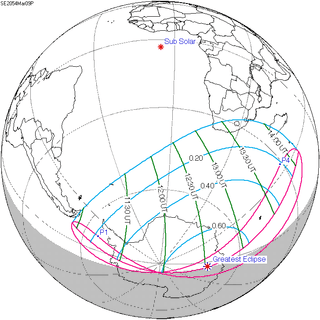 Partial |
155 | September 2, 2054 Partial |
Saros 130
It is a part of Saros cycle 130, repeating every 18 years, 11 days, containing 73 events. The series started with partial solar eclipse on August 20, 1096. It contains total eclipses from April 5, 1475 through July 18, 2232. The series ends at member 73 as a partial eclipse on October 25, 2394. The longest duration of totality was 6 minutes, 41 seconds on July 11, 1619.[1]
| Series members 43–56 between 1853 and 2100 | ||
|---|---|---|
| 43 | 44 | 45 |
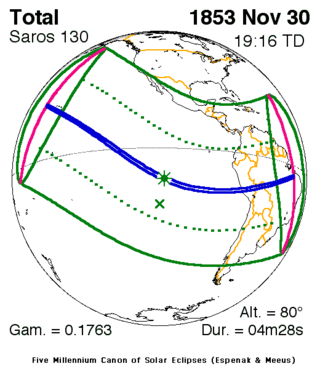 November 30, 1853 |
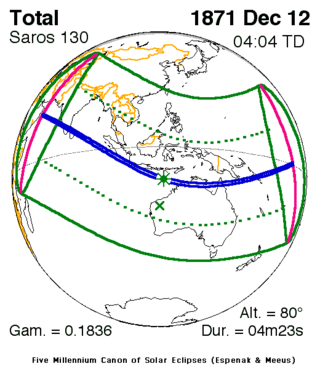 December 12, 1871 |
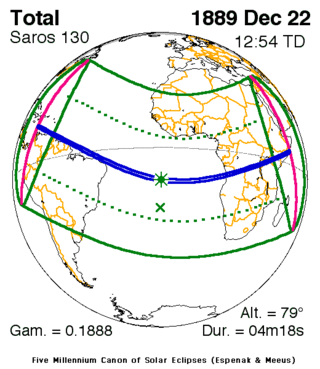 December 22, 1889 |
| 46 | 47 | 48 |
 January 3, 1908 |
 January 14, 1926 |
 January 25, 1944 |
| 49 | 50 | 51 |
 February 5, 1962 |
 February 16, 1980 |
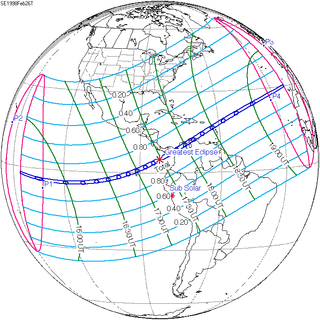 February 26, 1998 |
| 52 | 53 | 54 |
 March 9, 2016 |
 March 20, 2034 |
 March 30, 2052 |
| 55 | 56 | |
 April 11, 2070 |
 April 21, 2088 | |
Notes
References
- Earth visibility chart and eclipse statistics Eclipse Predictions by Fred Espenak, NASA/GSFC
| Wikimedia Commons has media related to Solar eclipse of 2052 March 30. |
